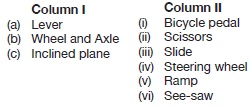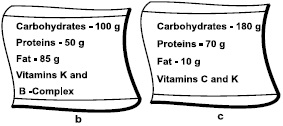Subject :NSO Class : Class 4
Subject :NSO Class : Class 7
When a person breathes in, what happens to the diaphragm and to the rib cage?
| Diaphragm | Rib cage | |
| A | Becomes flatten | Moves downwards and inwards |
| B | Becomes flatten | flatten Moves outwards and upwards |
| C | Becomes more curved | Moves downwards and inwards |
| D | Becomes more curved | Moves outwards curved and upwards |
Post Your Answer
Subject :NSO Class : Class 7
Post Your Answer
Subject :NSO Class : Class 7
Post Your Answer
Subject :NSO Class : Class 6
Ans 1:
Class : Class 6
D is the correct answer because the revolution of moon around the earth causes high tides and low tides and tree doesn't grow everyday.
Post Your Answer
Subject :NSO Class : Class 7
Post Your Answer
Subject :NSO Class : Class 7
Post Your Answer
Subject :NSO Class : Class 7
Post Your Answer
Subject :NSO Class : Class 7
Ans 1:
Class : Class 7
The seeds are boiled, meaning they should give off heat. Moreover, they are in a thermos flask, trapping the heat. Therefore, the temperature of flask Y should also increase. So the answer should be option "D".
Post Your Answer
Subject :NSO Class : Class 6
Refer to the given groups (i) - (iii). Each group contains an odd member. Identify the odd ones in each group and select the correct option.
(i) Calcium, Potassium, Iodine, Sodium
(ii) Vitamin A, Vitamin B, Vitamin D, Vitamin E
(iii) Oil, Cheese, Butter, Ghee
| (i) | (ii) | (iii) | |
| A | Calcium | Vitamin D | Butter |
| B | Iodine | Vitamin B | Oil |
| C | Sodium | Vitamin E | Cheese |
| D | Potassium | Vitamin K | Ghee |
I think answer C is correct
Ans 1:
Class : Class 3
I don't think it's B as for the last one, cheese is a rich source of protein while the others are full of fats. The correct answer is C
Ans 5:
Class : Class 9
For part (i.) the odd one out is iodineBecause Iodine is a micronutrient while calcium, potassium, and sodium are macronutrients.For part (ii.) odd one is Vitamin B.Because Vitamin B is water-soluble vitamin while Vitamin A, D, and E are fat-soluble vitamins.For part (iii.) the odd one out is OilSince oil is unsaturated fat while Cheese, Butter, and Ghee are the saturated ones.
Ans 13:
Class : Class 6
Explaination=1) Iodine is the odd one as it is a trace mineral (required in small amounts)2) Vitamin B is water soluble while the others are fat soluble 3) Oil is an unsaturated while the others are saturated







